|
Number of features of cooled, slow-scan G2CCD cameras with
USB 2.0 interface support demanding scientific
applications:
Very high sensitivity with peak QE above 80%. Lowest possible system read noise, limited by CCD chip
itself. High dynamic range (16-bits digitization) and linear
response. Efficient and precisely regulated cooling. Optional heat exchanger for liquid coolant. Ability of unattended operation enabled by integrated shutter
and filter wheel supporting UBVRI or narrow-band filters.
But G2CCD cameras are also designed with the needs of
amateur astronomers on mind:
Compact camera head, small and lightweight enough to be
attached even to small telescopes. Integrated all-in-one design with USB and power connectors
directly on the camera head. Integrated shutter not to bother with covering the telescope
when taking dark frames. Integrated filter wheel for standard filters to take (L)RGB
or narrow-band images. Single-voltage power supply enabling operation from
12V battery or “brick” adapter. Plug and play installation. Robust construction to sustain every-day usage. Rich software support.
No matter if your target is reliable scientific data or beautiful
images of deep-sky objects, G2CCD cameras are able to provide
both.

G2 CCD camera head G2CCD series of CCD cameras include three models:
| Model |
CCD Chip |
Resolution |
Pixel size |
Imaging area |
Download time |
| G2-0402 |
KAF-0402ME |
768 × 512 |
9 × 9 μm |
6.9 × 4.6 mm |
~ 0.6 s |
| G2-1600 |
KAF-1603ME |
1536 × 1024 |
9 × 9 μm |
13.8 × 9.2 mm |
~ 2.1 s |
| G2-3200 |
KAF-3200ME |
2184 × 1472 |
6.8 × 6.8 μm |
14.9 × 10 mm |
~ 4.8 s |
G2CCD cameras are designed to work in cooperation with a
host Personal Computer (PC). As opposite to digital still cameras,
which are operated independently on the computer, the scientific
slow-scan, cooled cameras usually require computer for operation
control, image download, processing and storage etc. To operate G2
CCD camera, you need a computer which:
Is compatible with a PC standard. Runs a modern 32-bit Windows operating
system. Provides at last one free USB port.
G2CCD Cameras Technical Specifications
CCD Chip
G2 cameras use high sensitive and low noise Kodak KAF Full
Frame CCD detectors. Advanced manufacturing techniques like
transparent electrodes and microlensing ensure up to 80 or
90 % peak quantum efficiency. The
inherent dark current of these detectors is very low compared
to other scientific-grade CCDs, so the resulting image S/N
ratio is very good.
Model G2-0402
G2-0402 model uses 0.4 MPx Kodak
KAF-0402ME Class 1 or 2 CCD chip.
| Resolution |
768 (H) × 512 (V)
pixels |
| Pixel size |
9 μm (H) × 9 μm (V) |
| Imaging area |
6.9 mm (H) × 4.6 mm (V) |
| Full well capacity |
~100,000 e- |
| Output node capacity |
~220,000 e- |
| Dark current |
1 e-/s/pixel at 0 °C |
| Dark signal doubling temperature |
6.3 °C |
KAF-0402ME CCD chip specifications KAF-0402ME CCD chip and its Quantum
Efficiency Model G2-1600
G2-1600 model uses 1.6 MPx Kodak
KAF-1603ME Class 1 or 2 CCD chip.
| Resolution |
1536 (H) × 1024 (V)
pixels |
| Pixel size |
9 μm (H) × 9 μm (V) |
| Imaging area |
13.8 mm (H) × 9.2 mm (V) |
| Full well capacity |
~100,000 e- |
| Output node capacity |
~220,000 e- |
| Dark current |
1 e-/s/pixel at 0 °C |
| Dark signal doubling temperature |
6.3 °C |
KAF-1603ME CCD chip specifications KAF-1603ME CCD chip and its Quantum
Efficiency Model G2-3200
G2-3200 model uses 3.2 MPx Kodak
KAF-3200ME Class 1 or 2 CCD chip.
| Resolution |
2184 (H) × 1472 (V)
pixels |
| Pixel size |
6.8 μm
(H) × 6.8 μm (V) |
| Imaging area |
14.9 mm (H) × 10 mm (V) |
| Full well capacity |
~55,000 e- |
| Output node capacity |
~110,000 e- |
| Dark current |
0.8 e-/s/pixel at
0 °C |
| Dark signal doubling |
6 °C |
KAF-3200ME CCD chip specifications KAF-3200ME CCD chip and its Quantum
Efficiency Camera Electronics
16-bit A/D converter with correlated double sampling
ensures high dynamic range and CCD chip-limited readout noise.
Fast USB interface ensures image download time within seconds.
Maximum length of single USB cable is 5 m. This length can be extended for instance
to 10 m by using single USB hub
or USB active extender cable. Up to 100 m extension can be achieved with
third-party extender.
| ADC resolution |
16 bits |
| Sampling method |
Correlated double sampling |
| Read modes |
Standard (STD) |
| |
Low-noise (LN) |
| Horizontal binning |
1 to 4 pixels |
| Vertical binning |
1 to 4 pixels |
| Sub-frame readout |
Arbitrary sub-frame |
| TDI readout |
Yes, 2 ms
resolution |
| Computer interface |
USB 2.0 High Speed |
| |
USB 1.1 Full Speed compatible |
Camera electronics specifications Image download time depends on the CCD chip used in
particular camera model. Also the read noise depends on the
chip as well as on the read mode.
Standard read mode provides system read noise approx.
1 e- above CCD chip read
noise. LN (Low-noise) read mode is somewhat slower (approx.
1.2×), but
ensures system read noise equal or smaller than the
manufacturer-specified chip read noise.
Model G2-0402
| Gain |
1.5 e-/ADU
(1 × 1 binning) |
| |
2.3 e-/ADU (other
binnings) |
| System read noise |
12 e- RMS (LN read) |
| |
16 e- RMS (standard
read) |
| Full frame download |
0.6 s (LN read) |
| |
0.5 s (standard read) |
G2-0402 electronics specifications Model G2-1600
| Gain |
1.5 e-/ADU
(1 × 1 binning) |
| |
2.3 e-/ADU (other
binnings) |
| System read noise |
12 e- RMS (LN read) |
| |
16 e- RMS (standard
read) |
| Full frame download |
2.5 s (LN read) |
| |
2.1 s (standard read) |
G2-1600 electronics specifications Model G2-3200
| Gain |
0.8 e-/ADU
(1 × 1 binning) |
| |
1.3 e-/ADU (other
binnings) |
| System read noise |
8 e- RMS (LN read) |
| |
10 e- RMS (standard
read) |
| Full frame download |
5.6 s (LN read) |
| |
4.8 s (standard read) |
G2-3200 electronics specifications Notes:
Binning can be combined independently on both
axes ULN read noise depends on the CCD chip itself. If the
read noise of the particular chip is 11.5
e- RMS, the system read noise is also
11.5 e- RMS. Download times are valid for USB 2.0 host and may vary depending on host
PC. Times stated here were measured on
1.5 GHz
Pentium M based laptop computer. Download times
can be somewhat longer when connected to USB 1.1 host.
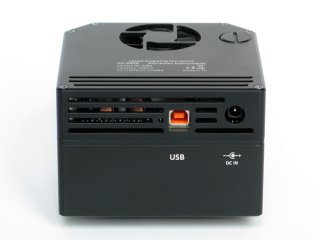
Power and USB connectors on the bottom of the
camera head Chip Cooling
Regulated two-stage thermo-electric chip cooling up to
50 °C below ambient temperature
with forced air cooling and 0.1 °C temperature precision ensure very low
dark current for long exposures.
| CCD chip cooling |
Thermoelectric (Peltier modules) |
| TEC modules |
Two stages |
| Max. delta T |
50 °C below ambient
maximum |
| |
45 °C below ambient
typical |
| Regulation precision |
0.1 °C |
| Hot side cooling |
Air cooling (50 mm
fan) |
Chip cooling specifications 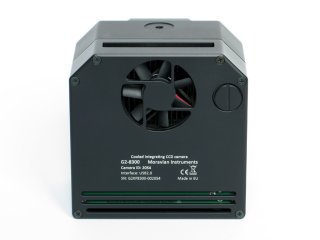
Fans and air output vents on the back side of the
camera Notes:
It is not recommended to cool the chip to the maximum
temperature difference, else the camera cannot guarantee
temperature stability when the ambient air temperature
rises. It is usually practical to set the temperature so the
cooling utilization varies around 90%. This provides enough
reserve in cooling power to keep the CCD temperature even if
the ambient temperature rises several degrees
Celsius. Water-assisted cooling is available for all G2CCD
cameras. Contact the manufacturer for details. The cooling performance depends on the environmental
conditions and also on the power supply. If the power supply
voltage drops below 12 V, the
maximum temperature difference is lower. One 50 mm fan is used in G2 cameras revision 3
and higher. Older revisions used two 40mm fans.
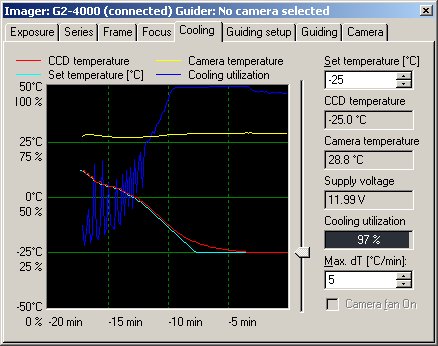
Maximum temperature drop -50°C provides little room
for regulation Power supply
The 12 V DC power supply adapter enables camera
operation from arbitrary power source including batteries,
wall adapters etc. Universal 100–240 V AC/50–60 Hz,
60 W “brick” adapter is
supplied with the camera. Although the camera power
consumption does not exceed 30 W,
the 60 W power supply ensures
noise-free operation.
| Camera head supply |
12 V DC |
| Camera power consumption |
15 W without
cooling |
| |
40 W with 100%
cooling |
| Adapter input voltage |
100-240 V AC/50-60 Hz |
| Adapter output voltage |
12 V DC/5 A |
| Adapter maximum power |
60 W |
Power supply specifications Notes:
Camera power consumption is measured on the AC outlet
of the 12 V power
supply. The camera contains its own power supplies inside, so
it can be powered by unregulated 12 V DC power source—the input voltage can be anywhere between 10
and 14 V. However, some
parameters (like cooling efficiency) can degrade if the
supply drops below 11 V. G2 CCD camera measures its input voltage and provides
it to the control software. Input voltage is displayed in
the Cooling tab of the CCD Camera
control tool in the SIPS. This feature is important
especially if you power the camera from batteries.
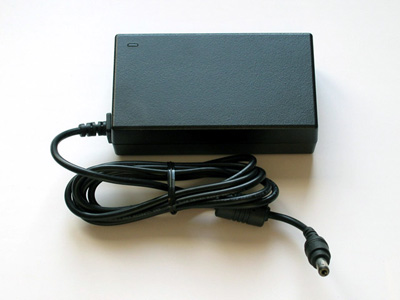
12 V DC/5 A power
supply adapter for G2CCD Camera Warning: The power connector on the camera head uses
center-plus pin. Although all modern power supplies use this
configuration, always make sure the polarity is correct if you
use own power source. Mechanical Specifications
Compact and robust camera head measures only 114 × 114 × 77 mm
(approx. 4.5 × 4.5 × 3 inches).
The head is CNC-machined from high-quality aluminum and black
anodized. The head itself contains USB-B (device) connector
and 12 V DC power plug, no other parts (CPU box, USB
interface, etc.), except a “brick” power supply, are
necessary. Integrated mechanical shutter allows streak-free
image readout, as well as automatic dark frame exposures,
which are necessary for unattended, robotic setups. Integrated
filter wheel contains 5 positions for standard
1.25" threaded filter cells. A variant
of filter wheel with 6 positions for 1"
“glass-only” filters is also available.
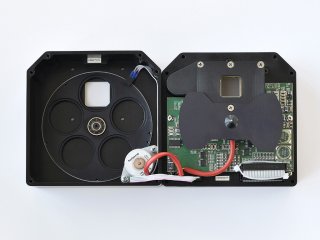
5-positions filter wheel and blade shutter inside
the G2 camera head
| Internal mechanical shutter |
Yes, blade shutter |
| Shortest exposure time |
100 ms |
| Longest exposure time |
Limited by chip saturation only |
| Internal filter wheel |
5 positions for 1.25" threaded
filter cells |
| |
6 positions for 1" bolt-secured filters |
| Head dimensions |
114 mm × 114 mm × 77 mm |
| Back focal distance |
29 mm |
| Camera head weight |
1.1 kg |
Mechanical specifications Slightly slimmer variant of the camera head without
internal filter wheel is available. The head dimensions are
114 × 114 × 65 mm
(approx. 4.5 × 4.5 × 2.5 inches).
This variant allows attaching of external filter wheel with 10
or 12 positions for D36 mm or
D31 mm filters.
G2 CCD camera with external filter wheel
attached External filter wheels for 10 filters D36 mm (left) and for 12 filters
D31 mm or with M28.5 × 0.6 threaded cells
(right)
| Head dimensions |
114 mm × 114 mm × 65 mm |
| Back focal distance |
29 mm |
| Back focal distance |
16.5 mm |
| Back focal distance from external filter wheel |
33.5 mm |
| Weight of camera head |
0.9 kg |
| Weight of camera head + external filter wheel |
1.7 kg |
Mechanical specifications Notes:
Shortest exposure time 100 ms is available on G2
cameras revision 3 and higher. Shortest exposure time of
older revisions was 175 ms.
Software Support
Powerful SIPS (Scientific Image Processing System) software
supplied with the camera allows complete camera control
(exposures, cooling, filters) with automatic sequences and
complete image calibration. SIPS also supports advanced tools like
Image Add tool with automatic sub-pixel image alignment, (L)RGB
Add tool, Image Blink tool, image filters and many more
functions.
Simple Image Manipulation System Drivers for third-party software are also available (e.g. MaxIm
DL, AstroArt, etc.). Visit the “download” portion of the
manufacturer web site for current list of available drivers,
please.
Automatic guiding
SIPS software package allows automatic guiding of the
astronomical telescope mounts using separate guiding camera.
Proper and reliable automatic guiding utilizing the
computational power of Personal Computer (e.g. calculation of
star centroid allows guiding with sub-pixel precision) is not
simple task. Guiding complexity corresponds to number of
parameters, which must be entered (or automatically measured).
And the number of necessary parameters lead to splitting of
the “Guiding” tab in the SIPS into two separate tabs.
The first one is called “Guiding setup” and it
summarizes all parameters necessary for proper autoguiding
setup.
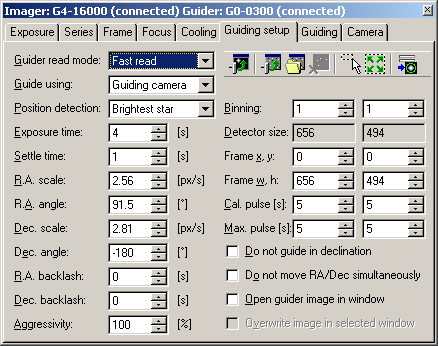
Guider setup tab of the SIPS CCD Camera control
tool The second tab called “Guiding” thereafter allows
switching of autoguiding on and off, starting of the automatic
calibration procedure and recalculation of autoguiding
parameters when the telescope changes declination without the
necessity of new calibration. Also swapping of the German
Equatorial mount no longer requires new autoguider
calibration.
This tab also graphically displays time history of guide
star offsets from reference position in both axes. The length
of graph history as well as the graph range can be freely
defined, so the graph can be adjusted according to particular
mount errors and periodic error period length.
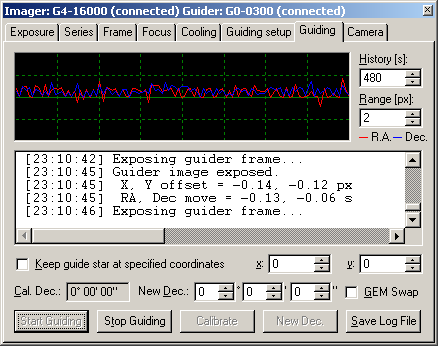
SIPS automatic guiding Complete log of calibration procedure, detected offsets,
correction pulses etc. is also shown in this tab. The log can
by anytime saved to log file.
G2 cooled imaging camera with G0 high-performance
guider Shipping and Packaging
G2 CCD cameras are supplied in the foam-filled, hard
carrying case containing:
Camera body with a user-chosen telescope adapter. The
standard 2" barrel adapter is included by default. If ordered,
the filter wheel is already mounted inside the camera head and
filters are threaded into place (if ordered). A 100-240 V AC input, 12 V DC output
“brick” adapter with 1.8 m
long power cable. 5 m long USB A-B cable for
connecting camera to host PC. A CD-ROM or USB Flash Drive with camera drivers,
SIPS software package with electronic documentation and PDF
version of User's Manual. A printed copy of camera User's Manual
G2 CCD cameras are shipped in the foam-filled carrying
case (left), larger case is used if camera is ordered with
external filter wheel (right) Image Gallery
G2 CCD cameras with KAF detectors are primarily intended for
research work. They are only occasionally used for “aesthetics
astrophotography”. Following examples represent both science
observations and astrophotography images.
Astronomy research
G2 cameras are appreciated by both professional researchers
and amateur astronomers involved in scientific observations.
Here are only a few examples, chosen from huge amount of
observations, be it extragalactic novae discovery, minor
planet photometry and astrometry, variable star discovery and
regular observations, exoplanet transit observations etc.
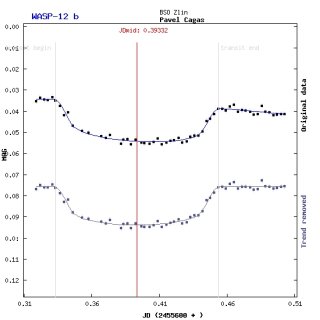 |
| Object |
WASP 12b exoplanet transit observation |
| Author |
Pavel Cagas |
| Camera |
G2-3200 |
| Telescope |
250mm f/5.4 reflector |
|
Only 0.8mmag RMS difference from ideal light
cure 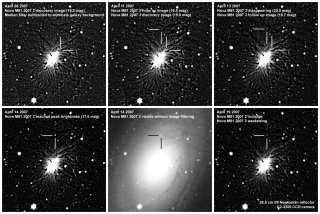 |
| Object |
Two new novae in M81 galaxy discovered within
three days |
| Author |
Pavel and Petr Cagas, Vaclav Pribik |
| Camera |
G2-3200 |
| Telescope |
265mm f/8 reflector |
|
This discovery is a record in the size of
telescope, used to discover nova in M81. The second smallest
has 750mm diameter. 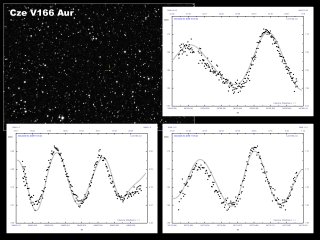 |
| Object |
New discovery of HADS (High Amplitude Delta
Scuti) variable star |
| Author |
Vaclav Pribik |
| Camera |
G2-1600 |
| Telescope |
254mm f/4.7 reflector |
|
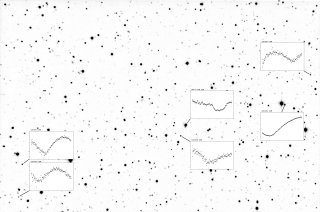 |
| Object |
5 new variable stars discovered during HAT-P
20b exoplanet transit observations |
| Author |
Vaclav Pribik |
| Camera |
G2-1600 |
| Telescope |
254mm f/4.7 reflector |
|
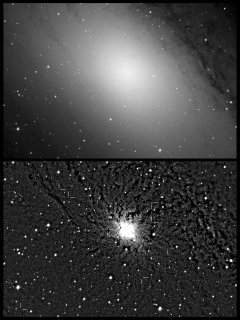 |
| Object |
9 novae in M31 galaxy |
| Author |
Kamil Hornoch |
| Camera |
G2-3200 |
| Telescope |
650mm f/3.6 reflector |
|
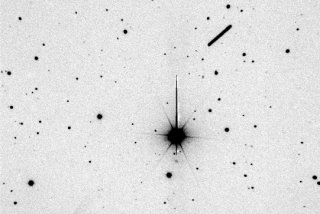 |
| Object |
Minor planet 2007/TU24 passing close to
Earth |
| Author |
Peter Kusnirak |
| Camera |
G2-3200 |
| Telescope |
650mm f/3.6 reflector |
|
Microscopy and material science
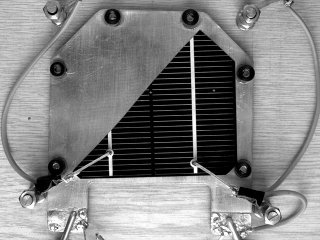 |
| Object |
Solar cell sample—visible light |
| Author |
Faculty of Electrical Engineering and
Communication, Brno University of Technology |
| Camera |
G2-3200 |
|
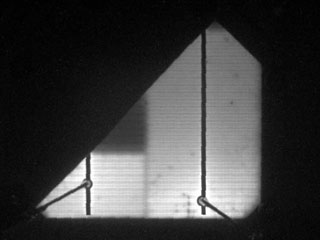 |
| Object |
Solar cell sample—near IR, conductive direction |
| Author |
Faculty of Electrical Engineering and
Communication, Brno University of Technology |
| Camera |
G2-3200 |
|
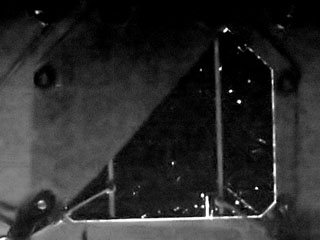 |
| Object |
Solar cell sample—near IR, micro-plasmas in barrier
direction |
| Author |
Faculty of Electrical Engineering and
Communication, Brno University of Technology |
| Camera |
G2-3200 |
|
Near-IR radiation of semiconductor (solar cell)
samples 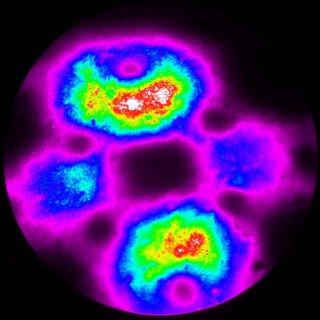 |
| Object |
Palladium layer on the tungsten sample
covered by tungsten oxide |
| Author |
J. Heyrovský Institute of Physical
Chemistry |
| Camera |
G2-0402 |
|
Field emission microscope images, camera field of
view is 800nm (1.5nm/pixel). Astrophotography
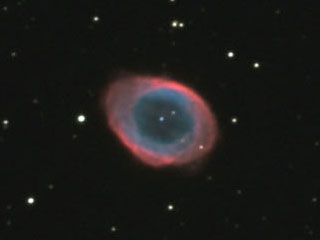 |
| Object |
M57 "Ring" nebula |
| Author |
Pavel Cagas |
| Camera |
G2-3200 |
| Telescope |
265mm f/8 Newtonian |
|
 |
| Object |
M27 "Dumbbell" nebula |
| Author |
Pavel Cagas |
| Camera |
G2-3200 |
| Telescope |
265mm f/8 Newtonian |
|
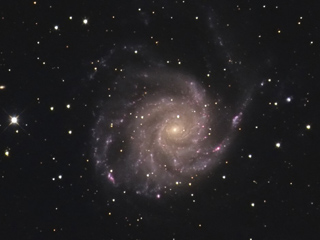 |
| Object |
M101 galaxy |
| Author |
Martin Myslivec |
| Camera |
G2-3200 |
| Telescope |
185mm f/3.9 astrograph |
|
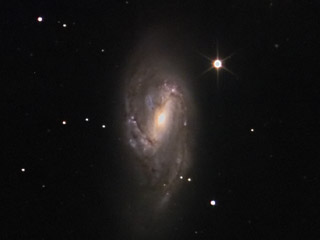 |
| Object |
M66 galaxy |
| Author |
Pavel Cagas |
| Camera |
G2-1600 |
| Telescope |
265mm f/8 Newtonian |
|
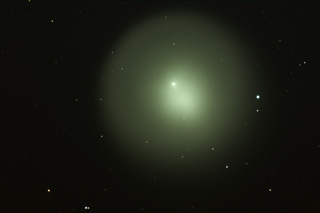 |
| Object |
Comet "Holmes" |
| Author |
Pavel Cagas |
| Camera |
G2-1600 |
| Telescope |
265mm f/8 Newtonian |
|
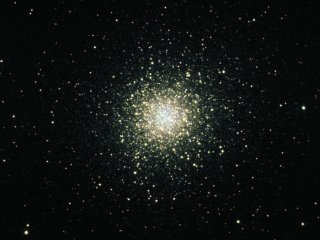 |
| Object |
Globular cluster M13 |
| Author |
Pavel and Petr Cagas |
| Camera |
G2-3200 |
| Telescope |
265mm f/8 Newtonian |
|
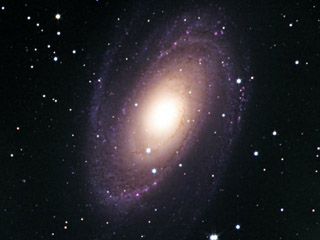 |
| Object |
M81 "Boode galaxy" |
| Author |
Pavel and Petr Cagas, Vaclav Pribik |
| Camera |
G2-3200 |
| Telescope |
265mm f/8 Newtonian |
|
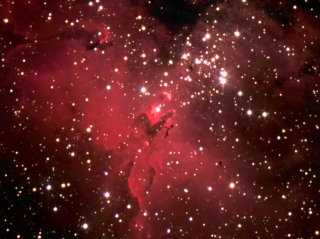 |
| Object |
M16 "Eagle nebula" |
| Author |
Pavel and Petr Cagas |
| Camera |
G2-3200 |
| Telescope |
265mm f/8 Newtonian |
|
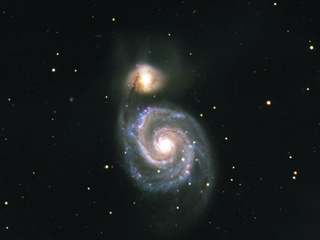 |
| Object |
M51 "Whirlpool galaxy" |
| Author |
Pavel and Petr Cagas |
| Camera |
G2-3200 |
| Telescope |
265mm f/8 Newtonian |
|
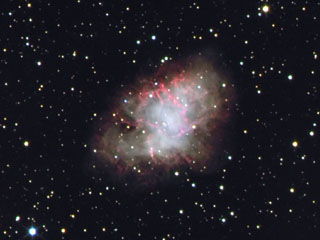 |
| Object |
M1 "Crab nebula" |
| Author |
Pavel Cagas |
| Camera |
G2-3200 |
| Telescope |
265mm f/8 Newtonian |
|
All images published with permission of their respective
authors.
| 